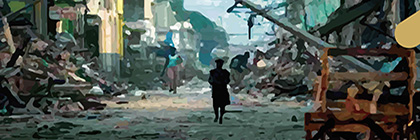An event organized by Osgoode Hall Law School’s Law.Arts.Culture will feature a lecture and discussion on the topic of “Perilous Light: On the Visual Economy of Western Humanitarianism” on Feb. 14.
 Professor Fuyuki Kurasawa of the Department of Sociology, in the Faculty of Liberal Arts & Professional Studies at York University, and director of the Global Digital Citizenship Lab, will lead the lecture and discussion that runs 12:30 to 2pm in Room 2027 of Osgoode Hall Law School.
Professor Fuyuki Kurasawa of the Department of Sociology, in the Faculty of Liberal Arts & Professional Studies at York University, and director of the Global Digital Citizenship Lab, will lead the lecture and discussion that runs 12:30 to 2pm in Room 2027 of Osgoode Hall Law School.
Simultaneously broadening and narrowing Godard’s statement – “Thus, the art form of the 19th century, cinema, made the 20th century exist, which by itself did not exist much.” (Jean-Luc Godard, Histoire(s) du cinéma) – one could argue that still and moving images made humanitarian crises exist, which by themselves would not have existed much as transnational public events in the Euro-American world during the last century, and even less so in our own.
Perhaps we understand this intuitively today, with social media platforms instantaneously flooding us with massive numbers of photographs and videos of instances of distant suffering from around the world. In such a heightened state of constant and intensifying visual exposure, images of this kind can appear to blur into a random, overwhelming, and meaningless digital stream that distracts and blinds as much as it mobilizes and enlightens.
However, out of this seeming pictorial morass can be detected a series of structural logics and esthetic principles that have organized into what can be referred to as Western humanitarianism’s visual economy.
To uncover the latter and analyze its operations, this presentation proposes a tripartite conceptual framework: the cultural repertoire of iconographic conventions through which images of humanitarian crises are invested with a certain meaning and recognized as such; the complex institutional networks of media and aid organizations that generate, select, and diffuse such images; and the iconological field in which these organizations compete with each other to establish the legitimacy of their preferred esthetic genres and politico-ideological framings of a crisis.
Having put forth this conceptual apparatus, the presentation will turn its application to specific famines or genocides whose pictorial corpus has been instrumental in the constitution of three periods of Western humanitarianism’s visual economy (nascent, totalizing and ambivalent iconophilia).
Throughout, the presentation will explore the status of images as culturally and politically contested evidentiary artifacts, whose meanings and standings in public spaces are the sources of perpetual symbolic struggles among social actors.
Lunch will be provided. Those interested can RSVP online.


